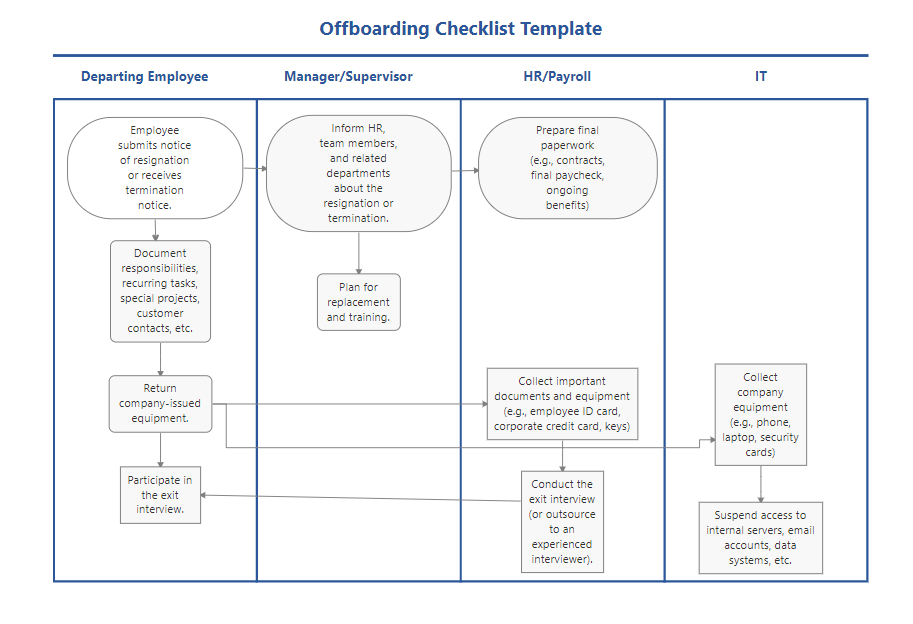Employees come and go, whether due to resignation, termination, or retirement. Having a solid offboarding strategy in place can help effectively manage their departure so you can focus on backfilling their role or reallocating their tasks and responsibilities.
Just as your onboarding process is important to get new hires up to speed, your offboarding process is important for mitigating security risks and gaining valuable insights on how to improve your company culture. Despite the benefits, only 29% of companies have a formal offboarding HR strategy.
In this article, we’ll examine what an offboarding checklist is, what elements should be covered by an effective offboarding checklist, and how visual tools can add structure and clarity to the entire offboarding process.
What is an employee offboarding checklist?
An offboarding checklist is an element of your overall HR strategy for managing the process of employees parting ways with your organization. It also safeguards against organizational risk by ensuring that former employees cannot access company data, systems, and networks once they leave.
Whether a former employee simply forgets to hand over data and access provisions, feels they are entitled to data they created for the company, or acts with malicious intent, 87% of former employees take organizational information with them. A proper offboarding checklist will help you recover company assets, including access rights, company-issued devices, and proprietary data.
Even if an employee is leaving your organization on good terms with little risk of a data breach or financial loss, it is still important to cover all the components of your offboarding process. This is because offboarding is a key opportunity to learn what your company is doing well and identify areas where you can improve.
5 elements of an effective offboarding checklist
Your offboarding checklist streamlines all the steps for transitioning an employee out of your company. A well-structured process mitigates security threats, provides valuable feedback for organizational growth, and can even improve the chances of regaining an employee who left voluntarily.
The following five elements will help you create a solid offboarding checklist for employees.
1. Communication of change
When an employee leaves their position, it is common for managers to delay communicating the change internally. However, the longer you wait, the more time coworkers will have to speculate their own theories about the departure.
Managers should inform their departments as quickly as possible to keep rumors from spreading. Then, make the following stakeholders aware of the change (as applicable to your organization and the employee’s job role):
- IT personnel
- Payroll
- HR team
- Clients or customers
- Legal team
- Security personnel
You don’t need to wait until you have all the details—simply tell relevant teams and departments that the person is leaving, and additional details will be provided as they come available. An efficient way to communicate the change is through an employee departure announcement.
Your employee departure announcement informs staff and external stakeholders that an individual is leaving the organization. The best way to do this is via a brief, professional email that covers the following details:
- The name of the employee who is leaving.
- The departure date.
- Transition details, such as task delegation or hiring a replacement.
- Farewell event, if applicable.
2. Proper documentation
Documentation is another important aspect of the early stages of your offboarding strategy. To protect yourself and employees against misunderstandings and legal issues, it’s important to address the following items:
- Letter of employment change. There are several ways to document a change in employment status, including letters of resignation, transfer, retirement, or termination. A written and signed acknowledgment of employee termination is especially important for legal liability. For example, employees who are part of a union or collective bargaining agreement must receive official notification of termination.
- Non-disclosure and non-compete agreements (as applicable). Non-compete agreements restrict an employee’s activity once they’re no longer with the organization, such as stipulating that they cannot open a competing business or work with your direct competitors. Non-disclosure agreements protect confidential information, such as your intellectual property or trade secrets.
- Severance package agreements. In cases of involuntary termination, a severance package agreement helps facilitate a smooth transition and waives the employee’s rights to make claims for civil violations against the company.
- After-employment benefits. Regardless of what prompted the departure, employees are entitled to certain benefits when they leave their job. This might include unemployment benefits, continued group health benefits, retirement plan transfers, and pay for unused time off.
3. Knowledge transfer
When an employee leaves your organization, they take their skills, insights, and organizational knowledge with them. Recording their best practices, documented processes, and other important information in a knowledge transfer plan ensures that their successor does not have to figure out the role on their own.
While specifics vary depending on the individual’s job role, be sure that there is a process in place to document and archive key elements, including:
- Overview of their daily routine.
- Recurring tasks or projects.
- Important contacts, both internal and external.
- High-priority tasks.
- Access to relevant systems and files.
- Training for various systems and responsibilities.
4. Asset recovery
As soon as the employee’s separation notice is submitted, inform both human resources and IT staff. Together, these departments share responsibilities for asset recovery and access revocation.
Company assets include both physical items as well as credentials and access rights to company accounts, software, systems, and networks. Collect any devices or other items issued to the employee, such as:
- Keys
- Laptops or computers
- Phones
- Security cards
- ID badges
Updating IT permissions and access is another important component of asset recovery. One in 20 organizations have no way of detecting if people who have left the company still had access to network services, which increases their risk of a data breach.
Revoke access to the following platforms (as applicable to the employee’s job role) immediately upon their departure:
- Email systems
- Software licenses
- Remote access tools
- Software-as-a-service (SaaS) accounts
- Corporate credit cards or expense accounts
- Identity and access (IAM) systems
- Data storage systems
Remove their user account for any relevant systems and change the password on shared accounts. You should also forward their emails and calls to their manager or another designated individual until someone is hired to take over their role.
5. Exit interview
The exit interview is a key element of your offboarding HR strategy because you can get feedback about problems affecting company morale and operational processes. Since finding a replacement and training a new hire can cost twice as much as the former employee’s salary, it is beneficial to understand why employees leave.
The insights gained from the exit interview should be part of an ongoing feedback loop to adjust practices and improve outcomes. By identifying common or recurring problems, you will be better positioned to address these issues before valuable employees leave the company.
To generate high-quality data, ask open-ended questions regarding your company’s culture, management, morale, and anything else relevant to your needs:
- How did your experience compare to your expectations coming into the role?
- Did you have adequate support and resources to do your job effectively?
- What skills and qualifications should we look for when evaluating new hires?
- How can we improve on specific issues?
- What would you say to your manager to help them do their job better?
- Would you recommend this company to a friend? If not, why?
The responsibility of conducting the exit interview typically falls to an internal HR person. In other instances, companies may outsource the exit interview to increase the likelihood of gaining honest feedback.
While exit interviews are confidential, it is good practice to ask if you can share specific insights with the departing employee’s supervisor or department head. Positive feedback identifies what is working well, while negative feedback offers the chance to improve operational processes and increase retention.
Use visual tools to streamline your offboarding process
An effective offboarding HR strategy can help create a positive final impression of your organization. This can reduce the likelihood of a former employee speaking negatively about the company with family, friends, on social media, and business review websites.
If a disgruntled former employee posts an anonymous negative review on sites such as Glassdoor, their words could impact how job seekers feel about your organization. Since 86% of potential candidates research your company’s reviews and ratings before applying for a role, it is important to give employees offboarding the time and attention to detail it requires.
Visual planning tools such as MindManager® help you make an effective offboarding checklist. With a variety of customizable templates available, you can modify checklists based on factors such as voluntary/involuntary termination and considerations related to the employee’s department or job role.
Visualizing your offboarding strategy also helps coordinate processes between multiple departments, including HR, IT, and the departing employee’s supervisor or manager.
For example, a swim lane diagram can be used to map out your company’s entire offboarding process from start to finish, as well as identify responsible parties for each step of the process.

Employee offboarding process in a swim lane diagram. (Source: MindManager swim lane template)
Your employee offboarding checklist helps you keep track of offboarding requirements and identify who is responsible for different aspects of an employee’s departure. With MindManager, it’s easy to save templates for future use and customize processes for a variety of offboarding needs.

